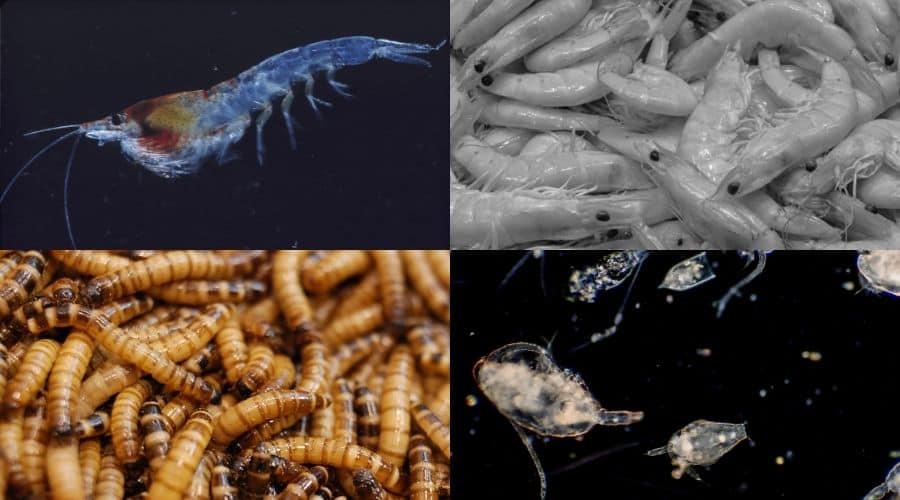The arctic is full of fish and other ocean life. When people look at images of the arctic and see vast fields of untouched white snow and empty glaciers, it gives a false impression that there’s nothing there, but that isn’t true.
Arctic biomes have as many species in their food web as anywhere else, so fish have numerous meal options. What do fish eat in the arctic?
Fish in the arctic eat other fish and at least a hundred species of bottom-dwelling creatures including arctic plankton, krill, worms, eels, snails, shrimp crabs, and octopuses living alongside many cold-water fish species. Together, these incredibly tough, well-adapted creatures form a complete and surprisingly diverse food web with fish of every size fitting into different niches to eat.
Table of Contents
What Do Fish Eat In The Arctic Ocean
Fishing in the Arctic ocean is one of the most dangerous jobs in the world, but only if you’re human. Alternately, the fish don’t have such a tough time catching smaller or slower fish to eat.
Since there are around two hundred and forty species of fish in the arctic, they make up a massive chunk of the food web on their own. However, there are plenty of other things to eat in the frigid waters.
Here are 9 things that fish eat in the arctic:
1 – Krill
These tiny shrimp-like creatures eat phytoplankton, and in turn, become a meal for fish and even massive animals like whales.
Arctic cod, in particular, are fond of krill and similar small invertebrate prey. Polar cod are vital food for other large predators, and they are among very few species that can thrive when temperatures drop below zero.
2 – Zooplankton
Forage fish are fond of eating zooplankton and readily scoop it up with their wide mouths.
According to Fisheries NOAA, “Pelagic or forage fish species are an important source of food for marine predators in the eastern Bering Sea. This group of fish includes capelin, Pacific herring, juvenile chum salmon, juvenile pink salmon, juvenile sockeye salmon, and walleye pollock during their first year of life.”
3 – Crabs
Sharks are large fish, and some live in the cold northern waters. Shark species have numerous sharp teeth that easily crack the tough outer shell of arctic crabs.
Dogfish sharks are particularly fond of seeking out crabs and lobsters. A shark eats 0.5 to 3.0 percent of its weight daily, which adds up to a substantial amount of crab meat over its thirty-five to forty-year lifespan.
4 – Cephalopods
Many people aren’t aware that octopuses live as far north as the arctic seas. However, Arcticus are bottom dwellers who use their beaks to eat young crabs and other small animals.
At a half-pound, they are smaller than some species of cephalopods in the area, but they make a nice meal for deeper diving fish like Arctic cod, who can swallow them whole.
5 – Worms
Fish’s fondness for worms is iconic, and arctic fish are no exception. There are twelve species of Sipunculids or non-segmented worms that live in the arctic.
According to Arctic Ocean Diversity they, “…inhabit all ocean depths from the littoral zone to the abyss. With few exceptions, sipunculids are detritivores. They inhabit sediments of various types but generally prefer silt and sand. Some species find refuge in empty mollusk shells or polychaete tubes.”
6 – Shrimp
Shrimp are a particular favorite of many arctic fish species. A few notable arctic shrimp eaters include arrowtooth flounder, halibut, Pacific cod, rockfish, sablefish, salmon, spiny dogfish, and walleye pollock.
Since shrimp are bottom feeders that eat dead animals and parasites, fish find them near the ocean floor. A strong jaw or a stronger stomach will make quick work of these highly sought-after meals.
7 – Snails
Like other shelled creatures that live in the ocean, snails are a favorite food for numerous fish. Some use powerful suction to pull the defenseless out of their shells, while other fish use their jaw muscles to crack them open.
8 – Sand Eels
The sand eel is another type of fish. They feed on zooplankton and are a staple in many northern birds’ diets.
However, most large fish also find their share of sand eels as they disturb the sea bed. Since this species is both a fish and favorite fish food, I’ve included them here.
An adult sand eel can reach up to a foot long. While they are cunning hiders who burrow down into the sand, these faux-eels also make a sizeable meal for any fish that is lucky enough or smart enough to dig one up.
9 – Mollusks
Cod use their pharyngeal teeth to crush the tough outer shells of mollusks. Once they’ve chewed through the outside to get the soft meat inside, it’s easy enough to spit out the hard shell pieces.
There are few small animals with or without shells that are safe from a hungry arctic cod.
Unfortunately for the mollusks and other small animals, these hardy hunters are the most abundant fish in the northern seas.
Since mollusks can be found from the depths to the upper boundaries of the inter-tidal region, they are a readily available food source for the cod.
Helpful Tips To Know About What Fish Eat In The Arctic
Cold weather doesn’t stop fish in the arctic from going about their business, eating meals, breeding, and generally living life.
Wherever there is a space in a food web, something will evolve to fill it up, and in the arctic oceans, a lot of those holes are filled with fish.
Here are more helpful tips to know about what fish eat in the arctic.
- Fish have an odd quirk of digestion. When their stomachs are full of food, they have more stomach acid, which is helpful for digesting tough prey like shellfish or snails.
- Most arctic fish are carnivorous, eating other animals to survive. In turn, they are eaten by humans, polar bears, and other, larger predators. Without arctic fish, the entire ecosystem in the north would collapse even on land. For example, salmon swim upriver to spawn feed numerous species even though they live most of their lives in the sea.
- Because the arctic waters are warming faster than other areas, the food chain for arctic fish is deeply affected. Subsistence and commercial fisheries are seeing fewer of these species and less of their preferred foods as the northern ice melts.
Final Thoughts
Arctic fish like cod and salmon can handle temperatures that would kill you and me. However, just because humans can’t live somewhere doesn’t mean we should underestimate its diversity.
From polar bears and whales to fish, crustaceans, cephalopods, and more, the waters at the top of the world are full of food options if you are adapted to hunt or scavenge there.
In fact, to stay healthy in near-frozen waters, most creatures need a thick layer of fat, and that means eating well and often.
Otherwise, they’d burn the fat off just swimming around, so fish in the arctic eat anything that doesn’t eat them first.

